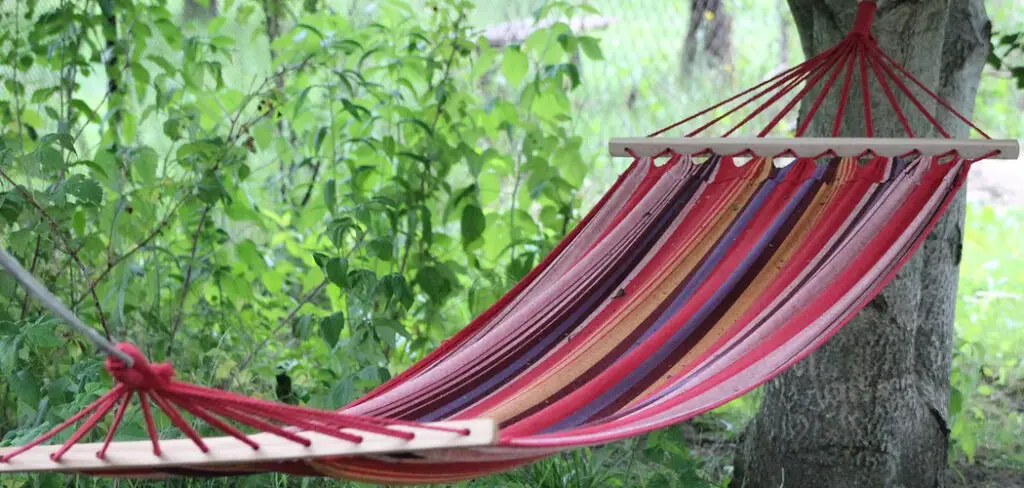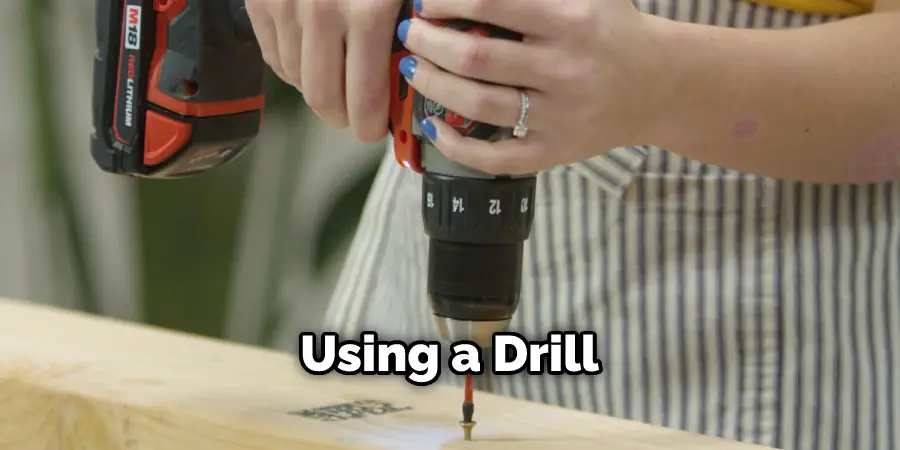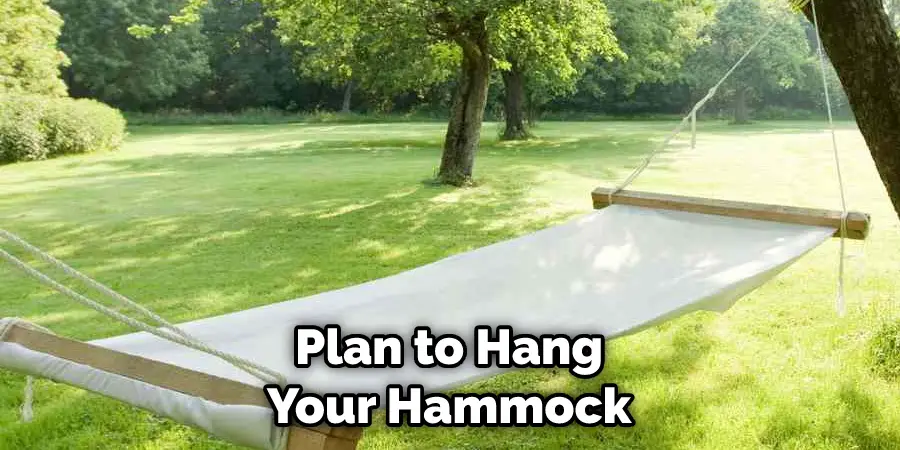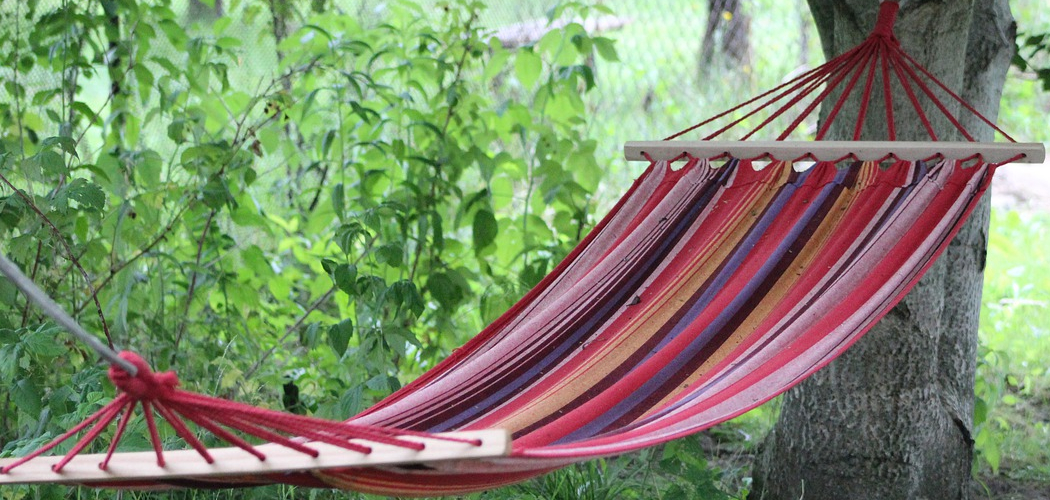Do you want to hang a hammock in your backyard but don’t have the trees or other support structures needed? Don’t let that stop you! Creating an outdoor oasis with a hammock doesn’t require any trees at all, and it can be done with minimal supplies. In this blog post, we’ll show you exactly how to hang a hammock without Trees.

You’ll learn what type of materials work best for setting up your own backyard paradise without spending a fortune on supplies. We’ll take away the frustration of figuring out how to get around those pesky obstacles so that you can just sit back and relax into one of the most comfortable pieces of furniture imaginable!
Needed Tools and Materials
- 2 x 6’s, 4 x 4’s, or other robust poles (wooden or metal)
- A drill with appropriate bits
- Lag bolts
- Hammock suspension kit
- Level (optional but helpful)
10 Steps on How to Hang a Hammock Without Trees
Step 1: Choose the Poles
Choose the right poles. 4 x 4’s and 2 x 6’s are good options, as they can provide more than enough support for a hammock setup. Hammock stands are also an option but can be more expensive. Choose the right size poles for your hammock setup.
Step 2: Mark the Poles
Use a pencil to mark where you plan to drill into the poles. Depending on how tall you want your hammock setup to be, measure and mark the appropriate spot for drilling. Marking the spots can also help when you are installing the lag bolts.
Step 3: Drill Holes

Using a drill and appropriate bit, create holes in both pieces of wood where you marked them. The size of the hole should be slightly larger than the diameter of your lag bolt. The holes should be deep enough to accommodate the length of the lag bolt and washer.
Step 4: Install Lag Bolts
Place one lag bolt in each hole, making sure that it is tight. Using a hammer or an adjustable wrench can help tighten them if necessary. The bolts should be secure enough that they don’t come loose easily.
Step 5: Attach the Suspension Kit
Once the lag bolts are installed, you can attach the suspension kit to them. Depending on the type of suspension kit you purchased, there may be different instructions for attaching it. Make sure to follow those instructions closely. The kit should be securely attached to the bolts so that it won’t come loose.
Step 6: Hang the Hammock
Once the suspension kit is installed, you can hang your hammock. Make sure it is evenly distributed between the two poles and securely fastened to the suspension kit. You should also check that it’s level before you get in it.
Step 7: Check Your Work

Before you spend any time in your hammock, make sure to check all of the bolts and that everything is secure. You don’t want your setup collapsing when you least expect it. Check for any signs of wear and tear and replace any worn-out parts.
Step 8: Enjoy!
Now that everything is set up, it’s time to enjoy your own backyard oasis. Grab a book or a nice beverage and settle into the hammock for some relaxation. Keep in mind that hammocks are not recommended for long periods of time and should only be used occasionally.
Step 9: Care and Maintenance
Be sure to perform regular care and maintenance on your setup. Check the bolts every few months or so, as well as any other parts that may need replacing. If you notice any signs of wear, tear, or rust, replace the parts promptly.
Step 10: Disassemble and Store
When you’re finished using your hammock setup, be sure to disassemble it and store it properly. This will prevent any damage or wear, as well as help preserve its longevity. If you have to move the setup at some point, be sure to do so carefully and follow the instructions for packing it properly.
With these steps, you’ll have no trouble creating your own backyard paradise without spending a fortune on supplies. With just a few simple tools and materials, you’ll be able to enjoy lounging in a hammock without needing access to trees or other supports. So grab your hammock, start gathering the necessary supplies, and get to work creating your dream backyard setup.
8 Safety Precautions to Take
- Make sure you have a safe and secure place to hang your hammock. Avoid setting up your hammock near sharp objects, unstable surfaces, or any other hazards. Choose the most stable option available.
- Inspect the area before you set up your hammock. Make sure there are no overhead wires or other potential hazards in the vicinity of where you plan to hang your hammock.
- Choose a spot that’s free from wind and direct sunlight. Strong winds can cause your hammock to swing uncontrollably, while direct sunlight can make the fabric of the hammock become hot and uncomfortable.
- Secure your attachment points with heavy-duty anchors that are designed to hold up to 500 pounds or more. Otherwise, the anchors may not be strong enough to keep your hammock in place.
- Check all of the components and hardware using them, such as carabiners, straps, and suspension lines. Make sure they are in good condition and capable of handling the weight they will be supporting.
- Ensure your attachment points (e.g., walls, posts, poles) can also handle the load you’re putting on them. Test by pulling on them to make sure they don’t move or give way. The best option is to use an anchor that’s rated for the weight of your hammock.

- Make sure there’s enough slack in your suspension lines and straps, so you don’t put too much tension on them. This can cause them to snap or break, leading to serious injury or death. Remember to adjust the tension as needed.
- Take time to relax and enjoy your hammock without worrying about safety issues. You can do this by making sure everything is secured properly and that you’ve taken all necessary precautions to ensure your safety.
5 Maintenance Tips
- Inspect your hammock and support system regularly for any signs of wear or damage. Check the straps, buckles, rope loops, and carabiners to ensure they are securely connected. If there is any sign of deterioration, replace them immediately.
- When using a hammock indoors or outdoors, make sure that it’s placed away from sharp edges, such as furniture or corners. This will protect your hammock from being cut or ripped by any sharp objects.
- When cleaning your hammock, use mild soap and warm water to avoid damaging the fabric. Allow it to dry completely before storing it away or using it again.
- While hanging your hammock without trees, keep an eye on the tension. If it’s too loose or too tight, it can cause sagging or stretching of the fabric.
- Store your hammock in a dry and cool place away from direct sunlight when not in use, as prolonged exposure to UV rays can cause damage to the fabric. Additionally, do not store your hammock when it is wet, as this will encourage the growth of mold and mildew.
By following these simple maintenance tips, you can ensure that your hammock remains comfortable, safe, and long-lasting! Whether you’re enjoying some outdoor relaxation or a cozy indoor nap, you’ll be able to hang your hammock without trees with ease and confidence.
How Much Will It Cost?
How much you spend on a hammock and the materials for hanging it without trees will depend on the type of hammock, support system, and mounting hardware that you purchase. The cost can range anywhere from $50 – $200, depending on the quality of materials and accessories.
If you’re looking for an affordable option, consider investing in a hammock chair for the indoors. With just one or two mounting hooks, you can quickly and easily hang your hammock without trees.

By following these tips, you’ll be able to find the perfect option that meets both your needs and budget!
Conclusion
From complex installations to a completely hands-free hanging system, there’s no shortage of methods for enjoying the comfort of your hammock in any outdoor space. In addition to gaining some fresh air and shade, hanging a hammock is an enjoyable way to relax with friends and family. Don’t forget that a hammock requires periodic care—in particular, regular cleaning and treating the ropes with a preservative if you want it to last.
Investing in the right tools, such as additional hooks or stands, ratchets, and tree slings, will make the process easier while providing peace of mind that your hammock is secure. Finally, understanding how to properly adjust your tension straps can help keep your hammock perfectly balanced all season long! With these helpful tips on how to hang a hammock without trees in mind, hang your hammock without worry and enjoy some restful bliss this summer!
You can check it out to Keep Patio Pavers from Moving


